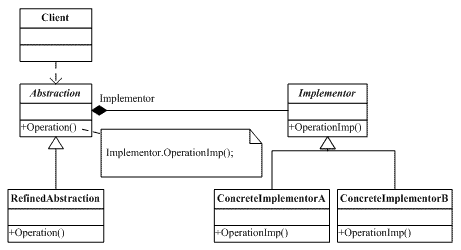一、 桥梁(Bridge)模式
桥梁模式是一个非常有用的模式,也是比较复杂的一个模式。熟悉这个模式对于理解面向对象的设计原则,包括"开-闭"原则(OCP)以及组合/聚合复用原则(CARP)都很有帮助。理解好这两个原则,有助于形成正确的设计思想和培养良好的设计风格。
我是这样理解的:对一个事物进行抽象,得到了一个行为。 比如对Shape进行抽象,得到了Draw的行为。Draw是在哪里实现的?不是在它抽象而来的类Shape,而是在另外一个类实现的。哪个类呢?Drawing类。
Draw是从Shape抽象出来的行为,但是不在Shape中予以实现。这就是抽象和实现分离。
为什么要这样呢?因为Draw的方法可能不同,比如可以用实线,也可以用虚线。为了更好的隐藏变化,所以将其分离。
二、 桥梁模式的结构
桥梁模式【GOF95】是对象的结构模式,又称为柄体(Handle and Body)模式或接口(Interface)模式。
下图所示就是一个实现了桥梁模式的示意性系统的结构图。

可以看出,这个系统含有两个等级结构,也就是:
- 由抽象化角色和修正抽象化角色组成的抽象化等级结构。
- 由实现化角色和两个具体实现化角色所组成的实现化等级结构。
桥梁模式所涉及的角色有:
- 抽象化(Abstraction)角色:抽象化给出的定义,并保存一个对实现化对象的引用。
- 修正抽象化(Refined Abstraction)角色:扩展抽象化角色,改变和修正父类对抽象化的定义。
- 实现化(Implementor)角色:这个角色给出实现化角色的接口,但不给出具体的实现。必须指出的是,这个接口不一定和抽象化角色的接口定义相同,实际上,这两个接口可以非常不一样。实现化角色应当只给出底层操作,而抽象化角色应当只给出基于底层操作的更高一层的操作。
- 具体实现化(Concrete Implementor)角色:这个角色给出实现化角色接口的具体实现。
三、 桥梁模式的示意性源代码
 // Bridge pattern -- Structural example
// Bridge pattern -- Structural example  using System;
using System;
 // "Abstraction"
// "Abstraction" class Abstraction
class Abstraction {
{ // Fields
// Fields protected Implementor implementor;
protected Implementor implementor;
 // Properties
// Properties public Implementor Implementor
public Implementor Implementor {
{ set{ implementor = value; }
set{ implementor = value; } }
}
 // Methods
// Methods virtual public void Operation()
virtual public void Operation() {
{ implementor.Operation();
implementor.Operation(); }
} }
}
 // "Implementor"
// "Implementor" abstract class Implementor
abstract class Implementor {
{ // Methods
// Methods abstract public void Operation();
abstract public void Operation(); }
}
 // "RefinedAbstraction"
// "RefinedAbstraction" class RefinedAbstraction : Abstraction
class RefinedAbstraction : Abstraction {
{ // Methods
// Methods override public void Operation()
override public void Operation() {
{ implementor.Operation();
implementor.Operation(); }
} }
}
 // "ConcreteImplementorA"
// "ConcreteImplementorA" class ConcreteImplementorA : Implementor
class ConcreteImplementorA : Implementor {
{ // Methods
// Methods override public void Operation()
override public void Operation() {
{ Console.WriteLine("ConcreteImplementorA Operation");
Console.WriteLine("ConcreteImplementorA Operation"); }
} }
}
 // "ConcreteImplementorB"
// "ConcreteImplementorB" class ConcreteImplementorB : Implementor
class ConcreteImplementorB : Implementor {
{ // Methods
// Methods override public void Operation()
override public void Operation() {
{ Console.WriteLine("ConcreteImplementorB Operation");
Console.WriteLine("ConcreteImplementorB Operation"); }
} }
}
 /// <summary>
/// <summary> /// Client test
/// Client test /// </summary>
/// </summary> public class Client
public class Client {
{ public static void Main( string[] args )
public static void Main( string[] args ) {
{ Abstraction abstraction = new RefinedAbstraction();
Abstraction abstraction = new RefinedAbstraction();
 // Set implementation and call
// Set implementation and call abstraction.Implementor = new ConcreteImplementorA();
abstraction.Implementor = new ConcreteImplementorA(); abstraction.Operation();
abstraction.Operation();
 // Change implemention and call
// Change implemention and call abstraction.Implementor = new ConcreteImplementorB();
abstraction.Implementor = new ConcreteImplementorB(); abstraction.Operation();
abstraction.Operation(); }
} }
}三、 桥梁模式的示意性源代码
 // Bridge pattern -- Structural example
// Bridge pattern -- Structural example  using System;
using System;
 // "Abstraction"
// "Abstraction" class Abstraction
class Abstraction {
{ // Fields
// Fields protected Implementor implementor;
protected Implementor implementor;
 // Properties
// Properties public Implementor Implementor
public Implementor Implementor {
{ set{ implementor = value; }
set{ implementor = value; } }
}
 // Methods
// Methods virtual public void Operation()
virtual public void Operation() {
{ implementor.Operation();
implementor.Operation(); }
} }
}
 // "Implementor"
// "Implementor" abstract class Implementor
abstract class Implementor {
{ // Methods
// Methods abstract public void Operation();
abstract public void Operation(); }
}
 // "RefinedAbstraction"
// "RefinedAbstraction" class RefinedAbstraction : Abstraction
class RefinedAbstraction : Abstraction {
{ // Methods
// Methods override public void Operation()
override public void Operation() {
{ implementor.Operation();
implementor.Operation(); }
} }
}
 // "ConcreteImplementorA"
// "ConcreteImplementorA" class ConcreteImplementorA : Implementor
class ConcreteImplementorA : Implementor {
{ // Methods
// Methods override public void Operation()
override public void Operation() {
{ Console.WriteLine("ConcreteImplementorA Operation");
Console.WriteLine("ConcreteImplementorA Operation"); }
} }
}
 // "ConcreteImplementorB"
// "ConcreteImplementorB" class ConcreteImplementorB : Implementor
class ConcreteImplementorB : Implementor {
{ // Methods
// Methods override public void Operation()
override public void Operation() {
{ Console.WriteLine("ConcreteImplementorB Operation");
Console.WriteLine("ConcreteImplementorB Operation"); }
} }
}
 /// <summary>
/// <summary> /// Client test
/// Client test /// </summary>
/// </summary> public class Client
public class Client {
{ public static void Main( string[] args )
public static void Main( string[] args ) {
{ Abstraction abstraction = new RefinedAbstraction();
Abstraction abstraction = new RefinedAbstraction();
 // Set implementation and call
// Set implementation and call abstraction.Implementor = new ConcreteImplementorA();
abstraction.Implementor = new ConcreteImplementorA(); abstraction.Operation();
abstraction.Operation();
 // Change implemention and call
// Change implemention and call abstraction.Implementor = new ConcreteImplementorB();
abstraction.Implementor = new ConcreteImplementorB(); abstraction.Operation();
abstraction.Operation(); }
} }
}

